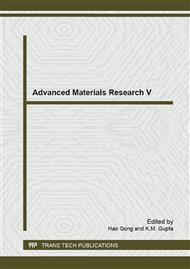p.305
p.311
p.315
p.320
p.325
p.331
p.335
p.339
p.346
Plastic Waste in Cement Concrete, LDPE and PVC Introduction Effect
Abstract:
We checker huge quantities of plastic with various forms and types. Major problems caused by these wastes in nature, inside the urban areas and countryside, impose a concern of increasing difficulties for reasons of hygiene and environment Cement concrete is a relatively inert and durable material, compact and waterproof, which can prevent contamination of the environment by living the harmful effects of plastic. In this context it was considered appropriate to include in concrete composition the elements of plastic waste (bag: LDPE) and (bottle: PVC) as a technique for recovery and reuse it’s in the cost. It is a simple and clean procedure to remove these dangerous elements and participate to preserve the nature. Results showed the possibility of using these types of plastic at ambient condition, as a substitution of aggregates, with a slight decrease in compressive strength on the percentage of substitution and an optimal increase in tensile resistance associated with a substantial gain in weight and a high removal rate, especially for PVC. These materials may be intended for the manufacture of components requiring less performance (small works, architectural concrete and decorative elements of the interior, filling, surface coverage and roof.).
Info:
Periodical:
Pages:
325-330
Citation:
Online since:
May 2015
Authors:
Keywords:
Price:
Сopyright:
© 2015 Trans Tech Publications Ltd. All Rights Reserved
Share:
Citation:


